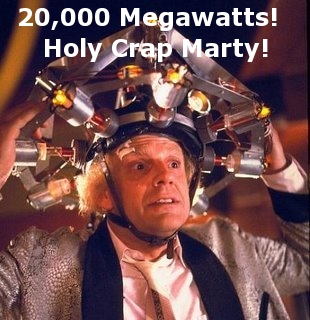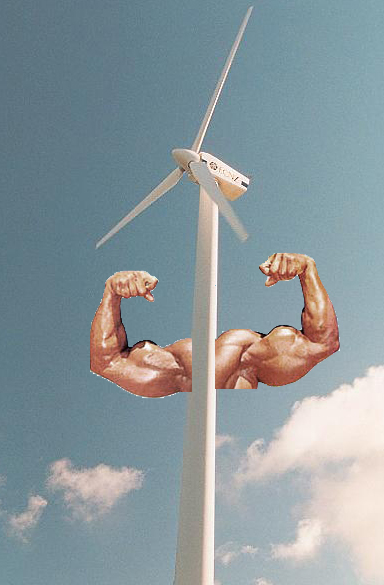Thats right people, put on your best Doc Brown voice and say it with me 1.21 jiggawatts 20,000 megawatts! (and yes before you complain I know he says jiggawatt instead of the proper gigawatt take it up with the movie).

The U.S. wind industry has raced past the 20,000-megawatt (MW) installed capacity milestone, achieving in two years what had previously taken more than two decades, the American Wind Energy Association (AWEA) said today (the 10,000-MW mark was reached in 2006). Wind now provides 20,152 MW of electricity generating capacity in the U.S., producing enough electricity to serve 5.3 million American homes or power a fleet of more than 1 million plug-in hybrid vehicles.
“Wind energy installations are well ahead of the curve for contributing 20% of the U.S. electric power supply by 2030 as envisioned by the U.S. Department of Energy,†said AWEA Executive Director Randall Swisher. “However, the looming expiration of the federal renewable energy production tax credit (PTC) less than four months from now threatens this spectacular progress. The PTC has been a critical factor in wind’s very rapid growth as a part of the nation’s power portfolio.†The PTC is currently set to expire at the end of 2008.
Swisher and other wind industry leaders noted the 20,000-MW milestone from Minneapolis, where the Republican National Convention is currently being held. Joining Swisher in Minneapolis were AWEA President Jim Walker, of enXco, as well as officials from other leading companies in the wind industry, including Xcel Energy, Vestas Americas A/S, Renewable Energy Systems Americas, and Horizon Wind Power.
Xcel Energy, the host utility for both the Republican convention and the Democratic National Convention held last week in Denver, is providing sufficient wind-generated electricity from its system to power both events. A 131-foot wind turbine blade, which has been on display at both conventions, was manufactured by wind turbine maker Vestas at a U.S. blade factory.
The 20,000 MW of wind power installed in the U.S. today can generate as much electricity every year as 28.7 million tons of coal or 90 million barrels of oil. Wind generation currently displaces 34 million tons of carbon dioxide annually, equivalent to taking 5.8 million vehicles off the road. A U.S. Department of Energy study released in May found that wind could provide 20% of U.S. electricity by 2030. At that level, wind power would support 500,000 jobs and reduce greenhouse gas emissions as much as taking 140 million vehicles off the road.

To put this into perspective geologists think that there is about 10.4 billion barrels of crude in the arctic national wildlife reserve (ANWR). Republicans will tell you that if we start drilling there today, in about 10 years (!) we will start seeing oil and in about 18 years (!!) it will peak at about 860,000 barrels a day. So it will take ten years to set up, produce almost no oil, 18 years to peek, and even with the boost reports show that America would still have to import 70% of its oil, and that the price difference per barrel would be 30 – 50 CENTS.
If we continue to build wind power at the current rate (5000 mw a year), by 2025 (the date ANWR would peek in production if we started today) we could build 105,000 MW of wind energy by 2025. Using the numbers above that would be an offset of 472,500,000 Million barrels of oil. But, but but, hey isn’t that not as much as what we would get with drilling! Good job, in fact thats about half as much, but thats not the whole picture.
Since the 70’s we have increased efficiency in this country about 1-2% year. so in 18 years we could assume 20-35% improvement in efficiency (that assumes we don’t pass any helpful laws to speed things up). So we would need less oil (hopefully), and we have yet to factor into the picture what burning all that oil will do to this country. We have to think about things like global warming, wars for oil, sea level rise, pollution, oil spills, climate refugees, virus and pest spreading to new warmer climates, loss of crop land, habitat loss, ocean acidification, mercury levels in fish, energy security etc. We also are not taking into account the increase in the use of solar/geothermal/biomass/tidal etc. energy sources. All of which make renewable energy the “cheaper” option (it would still cost a lot of money).
Of course this whole comparison misses a vital point. Even if you drilled for oil, in ANWR, off the coast, everyplace you could think of, eventually the oil will run out. All oil supplies are FINITE. When the oil runs out, the wind will still blow. Wind energy is an investment in the future, oil is just a quick fix. If you have ever put money away in a college fun for a child that is only a few years old you know that 20-30 years is not that long of a time to plan. Lets plan to keep America well powered for the next 1000 years (at least).
The U.S. is now the world leader in wind electricity generation. While Germany has more generating capacity installed (about 23,000 MW), the U.S. is producing more electricity from wind because of its much stronger winds. AWEA expects over 7,500 MW of new wind capacity to be added in 2008, expanding America’s wind energy fleet by 45% and bringing total U.S. capacity to some 24,300 MW.
Although 20,000 MW is an important milestone, wind power provides just over 1.5% of the nation’s electricity, far below the potential identified by experts. Still, it is one of the fastest-growing electricity sources today, providing 35% of the total new capacity added in 2007 (second only to natural gas). The U.S. had 1,000 MW of wind power installed by 1985; 2,000 MW installed by 1999; and 5,000 MW by 2003. Its first 10,000 MW was installed by mid-2006.
According to the U.S. Department of Energy’s 20% Wind Energy by 2030 report, wind power is capable of becoming a major contributor to America’s electricity supply over the next two decades. As an inexhaustible domestic resource, wind strengthens our energy security, improves the quality of the air we breathe, slows climate change, and revitalizes rural communities with good high paying jobs.
The US government should increase incentives for renewable power to help install more wind turbines. The future looks bright for these technologies. I am optimistic